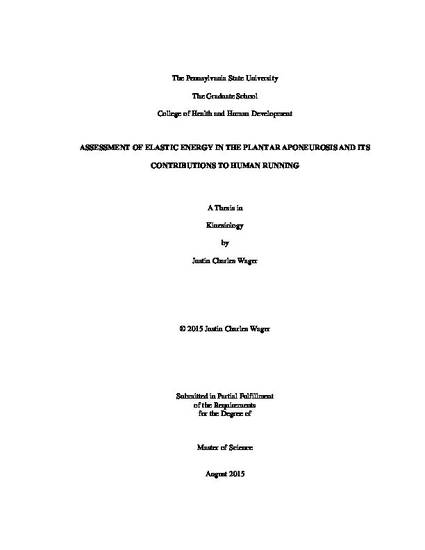
Thesis
Assessment of Elastic Energy in the Plantar aponeurosis and Its Contributions to Human Running
(2015)
Abstract
One of the primary roles of tendons during human locomotion is the storage and release of elastic energy. As the limbs move in cyclic patterns, some of the lower limb tendons stretch and recoil, functioning like springs that reuse a portion of the energy during each step. This function assists in improving the efficiency of human locomotion by reducing the work that is required of the muscles. Testing of cadaveric specimens in situ has demonstrated that the arch of the foot operates in this capacity during simple loading. However, it remains unclear whether the arch functions in this manner during the more complex task of human locomotion. Therefore, the aim of this study was to investigate one of the main elastic tissues in the arch (the plantar aponeurosis; PA), to examine its ability to store and release elastic energy that potentially contributes to the mechanical energetics of the foot during running. A second aim was to investigate the influence of the initial foot contact pattern on the function of the PA during the stance phase of running. A kinematically driven rigid-body model of the human foot was used to estimate the strain, tensile force, and elastic energy stored within the PA. Calculation of the foot joint moments, powers, and work created by the PA allowed an assessment of the contribution of the PA to the mechanical energetics of running gait. Elastic energy stored within the PA was found to be approximately 3 J, which is comparable to values found during in situ loading. The release of this elastic energy generated a small amount of joint power at the talonavicular joint. This joint power amounted to approximately 5-10% of the combined lower limb joint powers during late stance and contributed to push-off slightly after peak power generation at the ankle. In addition, this analysis revealed that differences existed in the early stance phase behavior of the PA between a non-rearfoot strike and a rearfoot strike, but that these differences did not exist during push-off. Future work will use these findings as a foundation to investigate how the mechanical power generated by the PA influences the energetics of other joints within the lower limb as well as the metabolic cost of locomotion.
Disciplines
Publication Date
August, 2015
Degree
M.S. Kinesiology
Department
Penn State University
Advisor
John H. Challis, Professor of Kinesiology
Comments
Link to thesis at Penn State University: https://etda.libraries.psu.edu/catalog/26210
Citation Information
Justin Charles Wager. "Assessment of Elastic Energy in the Plantar aponeurosis and Its Contributions to Human Running" (2015) Available at: http://works.bepress.com/justin-wager/2/
Creative Commons license

This work is licensed under a Creative Commons CC_BY-NC-ND International License.
